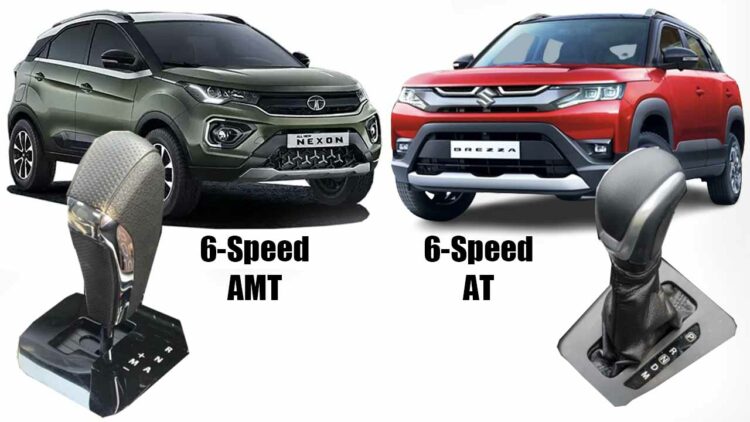Almost all major cars above the entry-level segment now give the buyers an option to choose between manual and some sort of automatic transmission.
Tata Nexon and Maruti Brezza are arch nemesis when it comes to the compact SUV segment in India. Nexon rose to the top 10 highest-selling cars in the country a long time ago and has stayed there consistently. Some of its enticing characteristics include a 5-star safety rating at the Global NCAP, bold and striking looks, the latest features and multiple powertrain options. On the other hand, Maruti Brezza has also been among the top-selling products in this category. Now, while the Nexon has a 6-speed AMT (Automated Manual Transmission) on offer, the Brezza has a 6-speed Torque Converter unit. Let us check out the differences between the two.
You may also like: Anti-Rust Coating for Car – Is It A Waste of Money?
Tata Nexon AMT
AMT is essentially a manual gearbox in its construction but the difference lies in the clutch operation. It has hydraulic actuators that control the clutch operation based on input from the transmission control unit (TCU) and the driver’s commands. This information is sent to the ECU along with other factors like throttle position, vehicle speed, engine speed and gear position. As a result, the system decides which gear to engage next and the hydraulic actuators release the clutch to engage that gear. The manual input of pressing the clutch paddle is eliminated enhancing the convenience. In principle, the system takes care of the clutch operation and allows massive convenience to the drivers in bumper-to-bumper traffic.
You may also like: 3M Car Care Treatment and Protection Plans With 2023 Price List
Pros
- AMTs are typically more fuel-efficient than other automatic transmissions.
- Because of their simple construction, they are less expensive to manufacture.
- As a result, the premium of buying it compared to the manual variant is low.
- The maintenance costs are low.
- The performance is predictable.
You may also like: LED vs HID Headlights in Cars – Which is Better?
Cons
- The operation can be quite jerky since the construction is simple.
- This could unsettle the passengers due to a lot of movement during the gear shifts, especially the lower gears.
- One could find the performance lacking.
You may also like: How To Fix Car Door Rattles and Squeaks Permanently – VIDEO
Maruti Brezza AT
Maruti Brezza has a 6-speed torque converter automatic gearbox. This is a much more complicated transmission in terms of its design and is regarded as a proper automatic transmission as opposed to the AMT, which is just a regular manual gearbox with the automated clutch operation. Hence, there are more components needed for its construction. Broadly, the torque converter assembly consists of a turbine, impeller, stator, pressure plates (clutch) and transmission fluid. Torque converter units work on the principle of fluid coupling.
You may also like: White Fog Lights vs Yellow Fog Lights – Pros and Cons
The impeller is connected to the engine and receives its power. Using the transmission fluid, it makes the turbine rotate which, in turn, is connected to the transmission shaft. This multiplies the torque that is being transmitted to the wheels. The flow of fluid is controlled using the stator blades that are located between the impeller and turbine. To engage and disengage the clutch, a computer-controlled hydraulic system is in place. All in all, the operation of a torque converter is quite sophisticated and smooth compared to something like an AMT.
You may also like: This is How a Tyre Puncture Repair Kit Works
Pros
- The operation is really smooth and one doesn’t feel the gearshifts, for the most part.
- They offer better performance and can be used for high-power cars as well.
- They incorporate various driving styles due to their construction.
- They are designed for heavy cars making them more durable.
- They have high torque multiplication for improved low-end torque and towing operations.
You may also like: How To Do Hill Start Without Handbrake
Cons
- Torque Converter transmission is more expensive.
- The construction is quite complex which means that the maintenance is also expensive.
- Fuel economy is not the priority with the Torque Converter gearboxes.
- These tend to be heavier than AMTs.
- These are less efficient because of the loss of energy because of the fluid coupling although a lot of these issues have been fixed in modern torque converter units.
You may also like: Nitrogen VS Air in Tires – Advantages and Disadvantages – VIDEO
Our Verdict
The decision to choose one over the other is not a foregone conclusion which is why both these transmissions are being appreciated by buyers. Both of these have their distinct appeal and downsides. On one side, the AMT is a great option for those who are looking for the convenience of an automatic gearbox without spending too much in terms of initial costs and subsequent maintenance costs. Also, it is great for people who value fuel economy over everything else.
You may also like: How To Use Tire Load Index Chart While Purchasing New Car Tires
On the other hand, the torque converter is a slightly more sophisticated mechanism which is why it is not offered in entry-level cars, to begin with. The preference of people buying cars with a torque converter transmission is ride quality, smooth driving and performance. Therefore, if budget is no constraint and you want a smoother unit, the torque converter is the right choice for you. If not, there are absolutely no issues with the AMT either.


